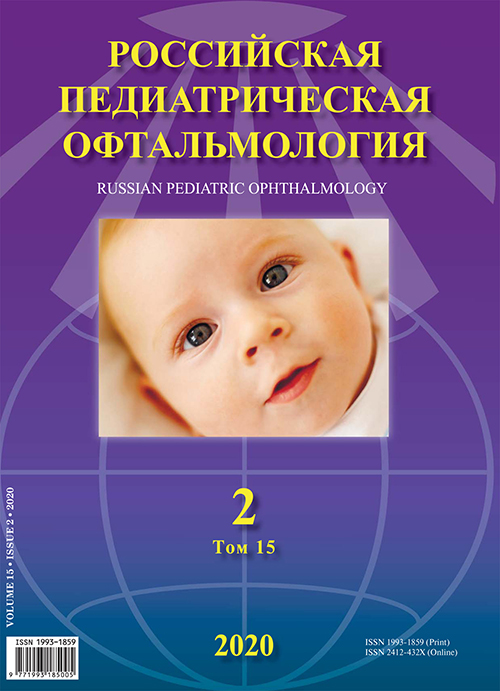А clinical case of WAGRO syndrome
- 作者: Sukhanova N.V.1, Katargina L.A.2, Zinchenko R.A.3, Marakhonov A.V.3, Vasilieva T.A.3,4
-
隶属关系:
- Federal State Budgetary Institution of Health’s Central Clinical Hospital of the Russian Academy of Sciences
- Helmholtz National Medical Сenter of Eye Diseases
- Research Centre for Medical Genetics
- N.A. Semashko National Research Institute of Public Health
- 期: 卷 15, 编号 2 (2020)
- 页面: 19-24
- 栏目: Case reports
- ##submission.datePublished##: 15.06.2020
- URL: https://ruspoj.com/1993-1859/article/view/59446
- DOI: https://doi.org/10.17816/rpo2020-15-2-19-24
- ID: 59446
如何引用文章
详细
WAGRO syndrome is a rare genetic syndrome that includes Wilms’ tumor, aniridia, genitourinary system abnormalities, mental retardation, and obesity. The syndrome is associated with deletions of the short arm of chromosome 11 (11p), where the PAX6 and WT1 genes are located. We present the clinical case of a 7-year-old boy with aniridia, polar cataract, and concomitant neuromotor, psychomotor, and speech delays. Evaluation of the child’s karyotype followed by confirmation using multiplex ligation-dependent probe amplification showed the presence of a deletion including in the 11p13-p14 region.
全文:
作者简介
Natella Sukhanova
Federal State Budgetary Institution of Health’s Central Clinical Hospital of the Russian Academy of Sciences
编辑信件的主要联系方式.
Email: natelasukhanova@gmail.com
ORCID iD: 0000-0003-4371-775X
MD
俄罗斯联邦, 117593, Moscow, Russian FederationLudmila Katargina
Helmholtz National Medical Сenter of Eye Diseases
Email: info@igb.ru
ORCID iD: 0000-0002-4857-0374
MD, PhD, Professor
俄罗斯联邦, 105062, Moscow, Russian FederationRena Zinchenko
Research Centre for Medical Genetics
Email: renazinchenko@mail.ru
ORCID iD: 0000-0003-3586-3458
MD, PhD, Professor
俄罗斯联邦, 115478, Moscow, Russian FederationAndrey Marakhonov
Research Centre for Medical Genetics
Email: marakhonov@gmail.com
ORCID iD: 0000-0002-0972-5118
PhD
俄罗斯联邦, 115478, Moscow, Russian FederationTatjana Vasilieva
Research Centre for Medical Genetics; N.A. Semashko National Research Institute of Public Health
Email: vasilyeva_debrie@mail.ru
ORCID iD: 0000-0002-1503-134X
научный сотрудник
俄罗斯联邦, 115478, Moscow, Russian Federation; 105064, Moscow, Russian Federation参考
- Lee H, Khan R, O’Keefe M. Aniridia: current pathology and management. Acta Ophthalmol. 2008;86(7):708-15. doi: 10.1111/j.1755-3768.2008.01427.x.
- Hingorani M, Hanson I, van Heyningen V. Aniridia. Eur. J. Hum. Genet. 2012;20(10):1011-7. doi: 10.1038/ejhg.2012.100.
- Gronskov K, Olsen JH, Sand A, et al. Population-based risk estimates of Wilms tumor in sporadic aniridia. A comprehensive mutation screening procedure of PAX6 identifies 80% of mutations in aniridia. Hum. Genet. 2001;109(1):11-8. doi: 10.1007/s004390100529.
- Hingorani M, Williamson KA, Moore AT, van Heyningen V. Detailed ophthalmologic evaluation of 43 individuals with PAX6 mutations. Invest. Ophthalmol. Vis. Sci. 2009;50(6):2581-90. doi: 10.1167/iovs.08-2827.
- McCulley TJ, Mayer K, Dahr SS, et al. Aniridia and optic nerve hypoplasia. Eye (Lond.). 2005;19(7):762-4. doi: 10.1038/sj.eye.6701642.
- Fischbach BV, Trout KL, Lewis J, et al. WAGR syndrome: a clinical review of 54 cases. Pediatrics. 2005;116(4):984-8. doi: 10.1542/peds.2004-0467.
- Han JC, Thurm A, Williams C, et al. Association of brain-derived neurotrophic factor (BDNF) haploinsufficiency with lower adaptive behaviour and reduced cognitive functioning in WAGR/11p13 deletion syndrome. Cortex. 2013;49(10):2700-10. doi: 10.1016/j.cortex.2013.02.009.
- Han JC, Liu QR, Jones M, et al. Brain-derived neurotrophic factor and obesity in the WAGR syndrome. N. Engl. J. Med. 2008;359(9):918-27. doi: 10.1056/NEJMoa0801119.
- Robinson DO, Howarth RJ, Williamson KA, et al. Genetic analysis of chromosome 11p13 and the PAX6 gene in a series of 125 cases referred with aniridia. Am. J. Med. Genet. A. 2008;146A(5):558-69. doi: 10.1002/ajmg.a.32209.
- Shinawi M, Sahoo T, Maranda B, et al. 11p14.1 microdeletions associated with ADHD, autism, developmental delay, and obesity. Am. J. Med. Genet. A. 2011;155A(6):1272-80. doi: 10.1002/ajmg.a.33878.
- Vasilieva TA, Voskresenskaya AA, Khlebnikova OV, et al. Differential diagnosis of hereditary forms of congenital aniridia from the perspective of modern genetics. Vestnik Rossiiskoi akademii meditsinskikh nauk. 2017;72(4):233-41. (In Russ.) doi: 10.15690/vramn 834.
- Marakhonov AV, Vasilyeva TA, Kutsev SI, et al. Method of Differential and Confirmatory Molecular Genetic Diagnostics of Congenital Aniridia and WAGR Syndromе. Patent RF 2641254 C1; 2018. (In Russ.)
- Marakhonov AV, Vasilyeva TA, Voskresenskaya AA, et al. LMO2 gene deletions significantly worsen the prognosis of Wilms’ tumor development in patients with WAGR syndrome. Hum. Mol. Genet. 2019;28(19):3323-6. doi: 10.1093/hmg/ddz168.
补充文件









